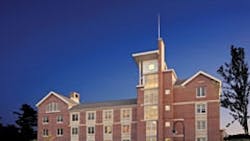20th Annual Residence Hall Construction Report
Even in difficult economic times, colleges and universities continue to invest in residence hall construction projects as a way to attract new students and keep existing ones on campus.
According to data from American School & University's 20th annual Residence Hall Construction Report, the median new project completed in 2008 was less expensive than the previous year in both total cost and cost per resident, and provided fewer total square feet. Although smaller in total size, new housing facilities accommodated more residents than those projects completed the year before, resulting in fewer square feet per student.
Data collected from 23 new residence hall projects completed in 2008 follow. Among the findings: the median new residence hall completed in 2008 was 60,000 square feet (down from 69,125 square feet in 2007) and accommodated 242 residents at a total cost of $8.5 million (compared with 204 residents and $11 million the year before).
Although the percentage of single-sex facilities and other specialized arrangements (such as housing for couples and families) increased from the year before, co-educational facilities remain the predominant type of new residence hall (68 percent).
With regard to financing new residence hall construction, a growing trend seems to be individual colleges/universities working in conjunction with private firms. Of those projects completed in 2008, 39 percent were paid for by a combination of institutional and private financing (compared with 16.6 percent in 2007).
The charts and tables that follow provide data by averages and medians, as well as list the various amenities provided in new residence hall facilities. For additional data, see the "Web Exclusive" area for exclusive data not found in the print version on residence hall construction expenditures, amenities and trend information for the past decade.
Residence hall construction (2008)
Makeup of new residence halls (2008)
Amenities in residence halls completed in 2008
How new residence hall construction was funded
At a glance
Overview of the median new residence hall constructed in 2008:
- Cost: $8.5 million
- Size: 60,000 square feet
- Residents: 242
- Cost/Sq. Ft.: $142
- Sq. Ft./Resident: 248
- Cost/Resident: $35,124
Project Snapshot: Phased living
The architect for this $40 million project initially developed a phased residential master plan for 1,450 new beds on 15 acres in the southeast quadrant of the University of New Hampshire's Durham campus.
In order to facilitate phased development, and to keep the scale of the buildings consistent with the existing context, the final plan is a series of six buildings clustered around various-sized courtyards and outdoor activity areas.
In phase I, two of the new residence halls abut an existing family housing cluster, thus clear definition of outdoor space and circulation was essential. In phase II, the building includes a mix of four- and six-bed suites and traditional double bedrooms. SERC A, B and C are all a mix of room types and offer interior common space, including main lounges, floor lounges, laundry facilities, kitchens, and residence hall and director apartments and offices. All of the facilities are air-conditioned.
Ultimately, with the completion of all phases, the residential community plans to include a small amphitheater, walking/biking paths, and a waterfront park. Environmental sustainability was a key consideration in the development of the site.
Architect for the project, which was completed in August 2008, is JSA Inc. (Portsmouth, N.H.)
Project Snapshot: Living and learning
Mount Ida College, Newton, Mass., has built the first new hall at the college since Malloy Hall was built in 1992. The new building, which houses about 130 students, represents the next generation of student housing. The three-story, 36,000-square-foot brick and stucco structure has an innovative design, modern technologies and energy-efficient features.
The building features two wings joined by glass bridges that glow at night. Two outdoor courtyards connected by a grand and open staircase surround the building. The courtyards tie the edges of the campus together and provide outdoor gathering places.
Living and learning spaces that encourage student interaction are an integral part of the design. The interior combines the best elements of more traditional residence halls into a "pod" design. Each of the six pods is a small community of 22 students who live in different types and sizes of rooms surrounding a common bath area. Lounges and study alcoves are situated in the bridges and hallways between the two wings on each floor.
The third floor of the North Pod houses a "quiet/study" living-learning community, and the top floor of the South Pod houses the 21+ floor, where students of legal age are permitted to possess alcoholic beverages in limited quantities.
The new hall also was designed to meet today's technology needs. All rooms have high-speed Internet access, and the entire building and surrounding courtyards have wireless Internet access. The building utilizes a one-card system that tracks entry into the building.
Funded by revenue bond debt and philanthropic support, the residence hall was completed in May 2008. The project was designed by Finegold Alexander + Associates, Inc. (Boston) and constructed by Cutler Associates (Worcester, Mass.).
Agron is editor of AS&U. Research conducted by Elinor Rice, senior research manager, Penton Media.
About the Author
Joe Agron
Editor-in-Chief and Associate Publisher
Joe Agron is the editor-in-chief/associate publisher of American School & University magazine. Joe has overseen AS&U's editorial direction for more than 25 years, and has helped influence and shape national school infrastructure issues. He has been sought out for comments by publications such as The Wall Street Journal, The New York Times, USA Today, U.S. News & World Report, ABC News and CNN, and assisted with the introduction of the Education Infrastructure Act of 1994.
Joe also authors a number of industry-exclusive reports. His "Facilities Impact on Learning" series of special reports won national acclaim and helped bring the poor condition of the nation's schools to the attention of many in the U.S. Congress, U.S. Department of Education and the White House.
